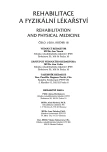Horáček O., Schreier B., Lisý J., Kobesová A., Kolář P.: Application of Neurophysiological Procedures in Neurogenic Pareses of Abdominal Wall
Authors:
O. Horáček 1; B. Schreier 1; J. Lisý 2; A. Kobesová 1; P. Kolář 1
Authors‘ workplace:
Klinika rehabilitace a TVL FN Motol a 2. LF UK, Praha, přednosta doc. PaedDr. P. Kolář, Ph. D.
1; Klinika zobrazovacích metod FN Motol a 2. LF UK, Praha, přednosta doc. MUDr. M. Roček, CSc.
2
Published in:
Rehabil. fyz. Lék., 18, 2011, No. 1, pp. 9-13.
Category:
Original Papers
Overview
Segmental pareses of abdominal wall result from damage to relevant neural roots or intercostals nerves in the extent of medullar segments Th5 to Th12. They are encountered in borreliosis and diabetes mellitus, in discogenic prolapse in the area of thoracic vertebral column, after kidney surgery, certain operations on the spine in certain tumors and as a consequence of sport overload.
In the paretic region there is usually muscular hypotonia, hypotrophy and deterioration of contraction ability. It becomes manifest as an arch of abdominal wall as well as disorders in the function of abdominal wall as a whole. The diagnostic is based on a timely beginning of a pointed rehabilitation which prefers neurophysiological procedures within the framework of therapeutic physical education, which more effectively support restoration of the function of paretic abdominal muscles and coordinated synergy of abdominal wall, diaphragm and pelvic floor. Dynamic neuromuscular stabilization using the elements of reflex loco motion and exercise of developmental series proved to be useful procedures.
Key words:
segmental pareses of abdominal wall, diagnostics, physiotherapy, dynamic neuromuscular stabilization
Sources
1. BILET, F. P. J., PONSSEN, H., VEENHUIZEN, D.: Unilateral paresis of the abdominal wall: A radicular syndrome cause by herniation of the L1-L2 disc? J. Neurol. Neurosurg. Psychiatry, 1989, 52, s. 678.
2. ČIHÁK, R.: Anatomie 1. Avicenum, Praha, 1987.
3. DICK, J. P. R.: The deep tendon and the abdominal reflexes. J. Neurol. Neurosurg. Psychiatry, 2003, 74, s. 150-153.
4. GÚTH, A., PALÁT, M.: Periférne obrny v rehabilitačnej medicíne. Rehabilitácia, 19, 1986, (Suppl. 33), s. 102–110.
5. HALADOVÁ, E. et al.: Léčebná tělesná výchova. Brno, Institut pro další vzdělávání pracovníků ve zdravotnictví, 1997.
6. HODGES, P. W. et al.: Contraction of the muscle diaphragm during postural adjustemens. J. Physiol., 505, 1997, 1, s. 539-48.
7. HODGES, P. W., GANDEVIA, S. C.: Activation of the human diaphragm during a repetitive postural task. Journal of Physiology, 522, 2000, 1, s. 165-175.
8. JANDA, V.: Funkční svalový test. Praha, Grada Publishing, 1996, s. 31-33.
9. KOLÁŘ, P. a kol.: Rehabilitace v klinické praxi. Galén, 2009, s. 233-246.
10. KOLÁŘ, P.: Vertebrogenní obtíže a stabilizační funkce svalů – diagnostika. Rehabilitace a fyzikální lékařství, 13, 2006, 4, s. 155-170.
11. LONGSTRETH, G. F.: Diabetic thoracic polyradikulopathy: Ten patiens with abdominal pain. Am. J. Gastroenterol, 1997, 92, s. 502-505.
12. MORMONT, E., ESSELINCK, W., DE RONDE, T. et al.: Abdominal wall weaknes and lumboabdominal pain revealing neuroborreliosis: a report of three cases. Clin. Rheumatol, 2001, 20, s. 447-450.
13. SŤĚTKÁŘOVÁ, I., CHROBOK, J., EHLER, E., KOT-LET, M.: Segmental abdominal wall paresis Cause by lateral low thoracic disc herniation. SPINE, 32, 2007, 22, s. 635-639.
Labels
Physiotherapist, university degree Rehabilitation Sports medicineArticle was published in
Rehabilitation & Physical Medicine

2011 Issue 1
Most read in this issue
- Pánek D., Čemusová J., Pavlů D.: Diaphragm Paresis and Its Kinesiologic Consequence
- Horáček O., Schreier B., Lisý J., Kobesová A., Kolář P.: Application of Neurophysiological Procedures in Neurogenic Pareses of Abdominal Wall
- Benešová M., Holubářová J., Pánek D., Pavlů D.: The Use of Proprioceptive Neuromuscular Facilitation in Patients with Desault Fixation of Shoulder Joint
-
SVALOVÉ SYNERGIE HORNÍ KONČETINY:
POLYEMG STUDIE PRO KLINICKOU PRAXI
